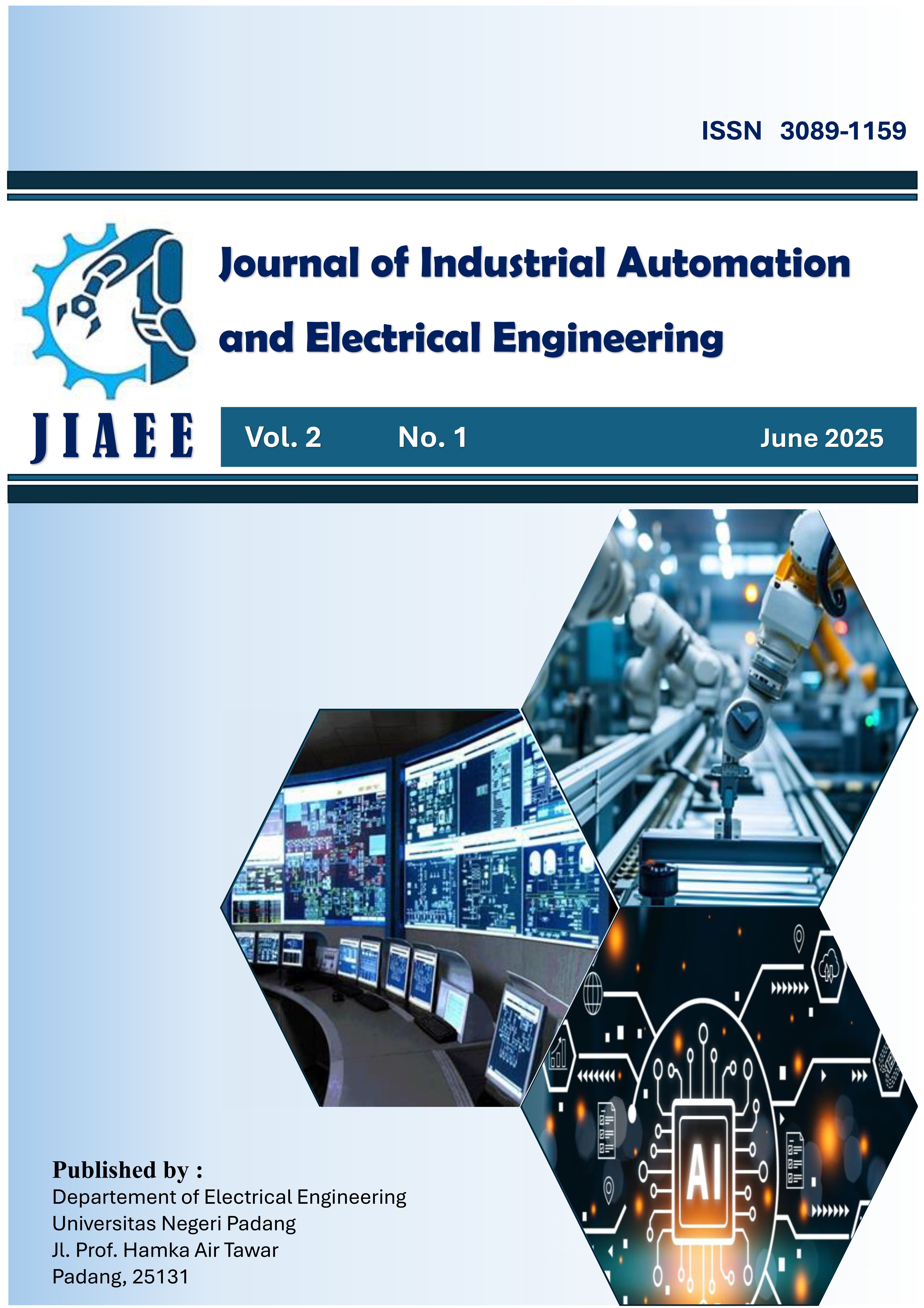Effect of robot speed on cycle time and success rate in Automated Cover Assembly and Screwing
DOI:
https://doi.org/10.24036/29x36k07Keywords:
Industrial Robot, Assembly Process, Screwing, Cycle time, Success rateAbstract
This study investigates the effect of robot speed on cycle time and success rate in an automated cover assembly and screwing process. The experimental method was used to collect data by systematically varying the robot’s movement speed and observing its impact on performance metrics. Experiments were conducted on a six axis Epson C4 industrial robot integrated with a Siemens S7 1200 programmable logic controller (PLC). Robot speed was adjusted across ten predefined levels from 6% to 33% of maximum velocity in 3% increments and for each level, three repeated trials were executed under controlled conditions. Results show that increasing speed from 6% to 33% reduces average cycle time from 908.6 s to 503.6 s for 4 product (227,1s–125,9s per product), a 44.6% improvement in efficiency. The relationship between speed and success rate is nonlinear: moderate speeds (27%–30%) yield an optimal success rate of 93.75% with cycle times of 517 s–533 s for 4 product (129s–133s per product), whereas both lower and maximum speeds decrease reliability due to vacuum pickup misalignment and screw retrieval inconsistencies. These findings underscore the need to balance speed and precision to optimize both efficiency and reliability in robotic assembly systems
Downloads
References
[1] H. T. Anaam K I and P. A. Y. W. Pranata R Y, Abdillah h, “Pengaruh Trend Otomasi Dalam Dunia Manufaktur dan Industri,” Vocat. Educ. Natl. Semin., vol. 1, no. 1, pp. 46–50, 2022.
[2] L. Liu, “Application Status and Development Trend of Industrial Robots in China,” no. Ieesasm, pp. 249–255, 2020, doi: 10.25236/ieesasm.2020.048.
[3] Ş. Çiğdem, I. Meidute-Kavaliauskiene, and B. Yıldız, “Industry 4.0 and Industrial Robots: A Study from the Perspective of Manufacturing Company Employees,” Logistics, vol. 7, no. 1, 2023.
[4] A. Minsandi et al., “Design and Implementation of Robot Abu Robocon Using Joystik Wireless Based on Extrasenory Percepsion,” J. Ind. Autom. Electr. Eng., vol. 01, no. 01, pp. 39–45, 2024
[5] M. P. Cooper, C. A. Griffiths, K. T. Andrzejewski, and C. Giannetti, “Motion optimisation for improved cycle time and reduced vibration in robotic assembly of electronic components,” AIMS Electron. Electr. Eng., vol. 3, no. 3, pp. 274–289, 2019, doi: 10.3934/ElectrEng.2019.3.274.
[6] M. Morozov et al., “Assessing the accuracy of industrial robots through metrology for the enhancement of automated non-destructive testing,” IEEE Int. Conf. Multisens. Fusion Integr. Intell. Syst., vol. 0, no. 0, pp. 335–340, 2016, doi: 10.1109/MFI.2016.7849510.
[7] V. Bucinskas et al., “Improving Industrial Robot Positioning Accuracy to the Microscale Using Machine Learning Method,” Machines, vol. 10, no. 10, 2022, doi: 10.3390/machines10100940.
[8] A. Abustan and R. Syam, “Omniwheels Dengan Manipulator Untuk Robot Penjinak Bom,” mekanikal, vol. 6, no. 1, pp. 557–564, 2015.
[9] J. Marvel and J. Falco, “Best Practices and Performance Metrics Using Force Control for Robotic Assembly,” 2012, [Online]. Available: http://nvlpubs.nist.gov/nistpubs/ir/2012/NIST.IR.7901.pdf
[10] H. K. Banga, P. Kalra, R. Kumar, S. Singh, and C. I. Pruncu, “Optimization of the cycle time of robotics resistance spot welding for automotive applications,” J. Adv. Manuf. Process., vol. 3, no. 3, pp. 1–11, 2021, doi: 10.1002/amp2.10084.
[11] Risfendra, Yoga Maulana Putra, H. Setyawan, and M. Yuhendri, “Development of Outseal PLC-Based HMI as Learning Training Kits for Programmed Control Systems Subject in Vocational Schools,” in 5th Vocational Education International Conference, 2023, pp. 506–511.
[12] S. Gürel, H. Gultekin, and N. Emiroglu, “Scheduling a dual gripper material handling robot with energy considerations,” J. Manuf. Syst., vol. 67, pp. 265–280, 2023.
[13] P. Huang, R. Liu, C. Liu, and J. Li, “APEX-MR: Multi-Robot Asynchronous Planning and Execution for Cooperative Assembly,” vol. 1, 2025, [Online]. Available: http://arxiv.org/abs/2503.15836
[14] X. Sun and C. Peng, “Novel Motion Control System for Industrial Robot Arms Enhanced by Innovative Method and PLC Integration,” in 2024 IEEE 33rd International Symposium on Industrial Electronics (ISIE), 2024, pp. 1–6. doi: 10.1109/ISIE54533.2024.10595769.
[15] D. Spensieri, E. Åblad, R. Bohlin, J. S. Carlson, and R. Söderberg, “Modeling and optimization of implementation aspects in industrial robot coordination,” Robot. Comput. Integr. Manuf., vol. 69, p. 102097, 2021, doi: 10.1016/J.RCIM.2020.102097.
[16] Y. Chuangui, M. Liang, L. Xingbao, X. Yangqiu, Q. Teng, and L. Han, “Uncertainty evaluation of measurement of orientation repeatability for industrial robots,” Ind. Robot Int. J. Robot. Res. Appl., vol. 47, no. 2, pp. 207–217, Jan. 2020, doi: 10.1108/IR-07-2019-0145.







